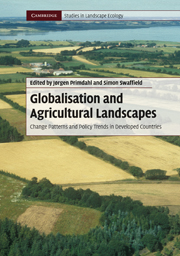Book contents
- Frontmatter
- Contents
- List of Contributors
- Preface
- 1 Globalisation and the sustainability of agricultural landscapes
- 2 Agricultural liberalisation, multifunctionality and the WTO: competing agendas for the future of farmed landscapes
- 3 Globalisation of agricultural landscapes: a land systems approach
- 4 Agricultural landscape changes through globalisation and biodiversity effects
- 5 Swiss agricultural policy reform: landscape changes in consequence of national agricultural policy and international competition pressure
- 6 Local landscape consequences of macro-scale policy reform: the New Zealand experiment
- 7 Rural landscape differentiation in the face of changing demands and policies: a typology of rural areas in Portugal
- 8 Globalisation and the local agricultural landscape: current change patterns and public policy interventions
- 9 From totalitarian to democratic landscapes: the transition in Estonia
- 10 Rural landscape change as a product of US federal policy
- 11 New approaches for urban–rural areas in Dutch spatial planning
- 12 Restoring agricultural landscapes in shrinking cities: re-inventing traditional concepts in Japanese planning
- 13 Globalisation and local agricultural landscapes: patterns of change, policy dilemmas and research questions
- Index
- References
10 - Rural landscape change as a product of US federal policy
Published online by Cambridge University Press: 05 June 2012
- Frontmatter
- Contents
- List of Contributors
- Preface
- 1 Globalisation and the sustainability of agricultural landscapes
- 2 Agricultural liberalisation, multifunctionality and the WTO: competing agendas for the future of farmed landscapes
- 3 Globalisation of agricultural landscapes: a land systems approach
- 4 Agricultural landscape changes through globalisation and biodiversity effects
- 5 Swiss agricultural policy reform: landscape changes in consequence of national agricultural policy and international competition pressure
- 6 Local landscape consequences of macro-scale policy reform: the New Zealand experiment
- 7 Rural landscape differentiation in the face of changing demands and policies: a typology of rural areas in Portugal
- 8 Globalisation and the local agricultural landscape: current change patterns and public policy interventions
- 9 From totalitarian to democratic landscapes: the transition in Estonia
- 10 Rural landscape change as a product of US federal policy
- 11 New approaches for urban–rural areas in Dutch spatial planning
- 12 Restoring agricultural landscapes in shrinking cities: re-inventing traditional concepts in Japanese planning
- 13 Globalisation and local agricultural landscapes: patterns of change, policy dilemmas and research questions
- Index
- References
Summary
Introduction
This chapter discusses three types of rural landscape change in America: changes within agricultural production, losses to rural towns and conversion of agricultural land to other uses (Figure 10.1). It describes how federal agricultural policy directly affects rural landscape change, and it will characterise potentials for international trade agreements to affect agricultural policy and rural landscapes. Other federal policies and laws that affect American rural landscapes less obviously but equally profoundly are also discussed. Federal agricultural policy interacts with policy for energy, the environment, housing, transportation, taxes and trade, as well as with the American legal system for land-use controls, all of which propel rural landscape change. At the nexus of all these forces, individual farm operators are confronted with a bewildering array of entrepreneurial opportunities, technological possibilities and policy options from which to make decisions about their farms each year. Only by critically and imaginatively examining these influential policies can we anticipate and affect the future condition and sustainability of local rural landscapes in America. The chapter is in four main parts – first, landscape condition and trends in the Corn Belt are summarised; second, relevant US federal policies are discussed in relation to aims of the WTO; third, the relationship of Corn Belt agriculture to federal policies is briefly reviewed, and finally, the prospect of alternative futures is examined.
- Type
- Chapter
- Information
- Globalisation and Agricultural LandscapesChange Patterns and Policy trends in Developed Countries, pp. 185 - 200Publisher: Cambridge University PressPrint publication year: 2010
References
- 6
- Cited by



